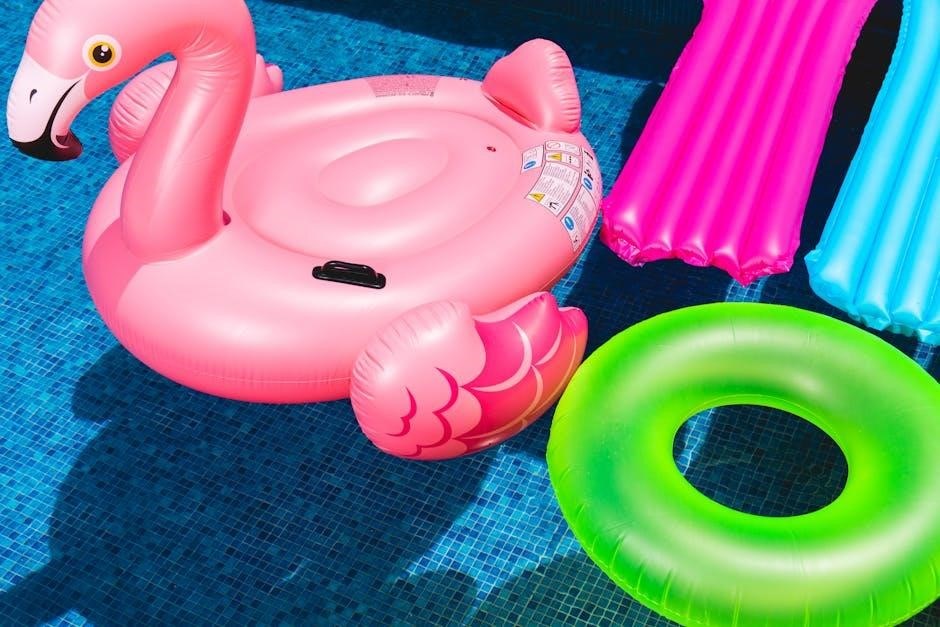Intex pool vacuums are essential for maintaining clean and safe swimming conditions. This guide provides step-by-step instructions for setting up, using, and troubleshooting your Intex pool vacuum effectively.
Overview of Intex Pool Vacuum Importance
Intex pool vacuums are crucial for maintaining a clean and hygienic swimming environment. Regular vacuuming removes debris, prevents algae growth, and ensures clear water. It also protects the pool filter from clogging and extends the lifespan of pool equipment. Proper vacuuming is essential for keeping your pool safe and enjoyable for swimmers, making it a vital part of overall pool maintenance.
Why Regular Vacuuming is Essential for Pool Maintenance
Regular vacuuming preserves water clarity, prevents algae buildup, and removes contaminants that can harm swimmers. It also prevents debris from damaging pool equipment and extends the filter’s lifespan. Consistent cleaning ensures a safe and enjoyable swimming experience, making it a cornerstone of effective pool care and maintenance.

Necessary Tools and Equipment
Essential tools include the Intex vacuum cleaner, telescoping pole, hose, and pool filter. These items ensure efficient and effective pool cleaning, maintaining your pool’s hygiene and functionality.
Required Items for Intex Pool Vacuum Setup
To set up your Intex pool vacuum, you’ll need the vacuum cleaner, a telescoping pole, a pool hose, and the pool filter. Additionally, ensure you have a connector for the hose to the vacuum and the filter. These items are crucial for proper suction and efficient cleaning. Always refer to your Intex manual for specific parts and connections to ensure compatibility and safe operation.
Additional Accessories for Effective Cleaning
For enhanced cleaning efficiency, consider using a pool brush to scrub walls and floors, a skimmer net to remove debris, and a crevice tool for tight spaces. A longer or adjustable hose can also improve reach and maneuverability. These accessories complement the Intex pool vacuum, ensuring a more thorough and effective cleaning process. They help maintain optimal pool hygiene and extend the life of your pool equipment.

Pre-Vacuuming Preparation
Before vacuuming, skim the pool surface to remove floating debris and ensure the pool filter is clean. This helps maintain optimal suction and ensures efficient cleaning.
Skimming the Pool Surface Before Vacuuming
Skimming the pool surface is a crucial first step before vacuuming. Use a leaf skimmer to remove floating debris like leaves and insects. This prevents clogging the vacuum and ensures efficient cleaning. Regular skimming maintains water clarity and prevents debris from sinking, making vacuuming more effective. A clean surface also enhances suction power, allowing the vacuum to pick up finer particles. Always skim thoroughly to achieve a sparkling, well-maintained pool.
Checking and Preparing the Pool Filter
Before vacuuming, ensure the pool filter is clean and functioning properly. A clogged filter reduces suction power, making vacuuming less effective. Turn off the pump, inspect the cartridge, and rinse or replace it if necessary. Proper filter maintenance ensures optimal water flow and prevents debris buildup. A clean filter also protects the vacuum motor from strain, ensuring efficient and effective pool cleaning. Regular checks are essential for maintaining your pool’s hygiene and longevity.
Assembling the Intex Pool Vacuum
Attach the hose to the vacuum head, ensuring a secure connection. Connect the telescoping pole and test all parts for proper fit. Follow the manufacturer’s instructions carefully.
Step-by-Step Assembly Guide
Begin by attaching the vacuum head to the telescoping pole, ensuring a secure connection. Next, connect the hose to the vacuum head, making sure it is tightened properly. If using an automatic cleaner, attach it to the pool’s filtration system. For manual vacuums, simply connect the hose to the skimmer or dedicated vacuum port. Always check for proper fit and alignment before use to ensure optimal performance.
Troubleshooting Common Assembly Issues
Common assembly issues include kinked hoses, improper connections, or air leaks. Check for bends in the hose and straighten them to ensure proper water flow. If connections feel loose, tighten all fittings securely. For automatic cleaners, ensure the vacuum head is correctly attached to the pool floor. If suction is weak, inspect for air leaks around connections and tighten as needed. Proper assembly ensures efficient cleaning performance.

Using the Intex Pool Vacuum
Use manual or automatic modes for efficient cleaning. Ensure proper suction by maintaining correct water levels and avoiding kinks in hoses for optimal performance and care.
Manual Vacuuming Techniques
Attach the vacuum head to the telescopic pole and connect the hose to the vacuum and pool skimmer. Submerge the vacuum slowly, ensuring no air enters the hose. Move the vacuum across the pool floor in steady, overlapping strokes to cover the entire area. Avoid stirring debris by moving too quickly. Regularly check for kinks in the hose and ensure the filter is clean for optimal suction.
How to Use Automatic Pool Cleaners
Automatic pool cleaners simplify maintenance by navigating the pool independently. Place the cleaner in the pool, ensuring it’s fully submerged. Connect it to the pool’s filtration system or use its built-in pump. Program the cleaner’s settings, if applicable, and let it run for the recommended time. Regularly empty the debris bag or canister and rinse the filter to maintain efficiency. This method saves time and ensures a thorough cleaning.

Tips for Effective Pool Vacuuming
Regular vacuuming prevents debris buildup and maintains water clarity. Use the right technique for your pool surface and ensure proper suction power for optimal cleaning results always.
Best Practices for Cleaning Different Pool Surfaces
For vinyl pools, use a soft-bristle brush to avoid damage. Concrete or fiberglass surfaces can withstand stiffer brushes. Tile surfaces require gentle cleaning to prevent scratching. Always adjust vacuum settings according to the surface type and clean in sections for thorough coverage. Regularly empty the pump basket to maintain optimal suction power and ensure efficient cleaning results.
Optimizing Suction Power and Flow
Ensure the pool vacuum hose is free from kinks or twists to maintain consistent suction. Regularly clean the pump basket and filter to prevent clogs that reduce flow. Use the correct vacuum settings for your pool size and type. Check the flow valve to ensure it’s fully open, allowing maximum water circulation. Proper maintenance enhances efficiency and keeps your pool clean with minimal effort.

Troubleshooting Common Issues
Address issues like loss of suction or clogged hoses by checking for kinks, blockages, or faulty connections. Ensure the pump and filter are functioning properly for optimal performance.
Solving Loss of Suction Problems
Losing suction? Check for kinks or blockages in the hose, which can restrict water flow. Inspect the pump basket and filter for debris, as clogs here can reduce suction power; Ensure all connections are tight and free of air leaks. If issues persist, clean or replace the filter cartridge and verify the pump is operating at the correct pressure for optimal performance.
Fixing Kinked or Blocked Hoses
Identify kinks or bends in the hose and straighten them. For blockages, inspect the hose for debris like dirt or leaves. Flush with water or use a brush to clear obstructions. Ensure the hose is properly aligned and free of twists. If compressed air is available, use it to dislodge stubborn clogs. Regularly check connections to the pump and vacuum for tightness to maintain proper suction and prevent future issues.

Maintenance and Storage
Regularly clean the vacuum and store it in a dry, cool place. Check for damage and replace worn parts promptly to ensure optimal performance and longevity.
Cleaning and Storing the Vacuum After Use
Rinse the vacuum thoroughly with fresh water to remove dirt and pool chemicals. Allow it to dry completely to prevent mold growth. Store it in a cool, dry place, away from direct sunlight. Check for any damage or blockages in the hose or other parts before storage. Regular cleaning and proper storage ensure optimal performance and extend the lifespan of your Intex pool vacuum.
Regular Maintenance for Longevity
Regular maintenance ensures your Intex pool vacuum performs efficiently and lasts longer. Inspect hoses for kinks or blockages and replace worn-out parts promptly. Check the filter cartridge regularly and clean or replace it as needed. Lubricate moving parts to prevent friction and corrosion. By following these steps, you can extend the lifespan of your vacuum and maintain peak performance for a cleaner pool. Proper care ensures reliability and durability over time.
Proper maintenance and regular cleaning ensure your Intex pool remains clean and safe. Follow these instructions to enjoy a sparkling, well-maintained pool all season long.
Importance of Following Instructions
Following instructions ensures your Intex pool vacuum operates safely and effectively. Proper setup and maintenance prevent issues like loss of suction or damaged hoses. Adhering to guidelines extends the product’s lifespan and guarantees a clean, safe pool environment. Consistency in these practices is key to enjoying your pool all season long.
Final Tips for a Sparkling Clean Pool
For a pristine pool, combine regular vacuuming with consistent skimming and filter maintenance. Adjust suction power based on pool size and debris levels. Clean the vacuum after use to prevent clogging and extend its lifespan. Store equipment properly to avoid damage. Regular checks and timely fixes ensure optimal performance. By following these tips, you’ll enjoy a clean, safe, and inviting pool all season long.

